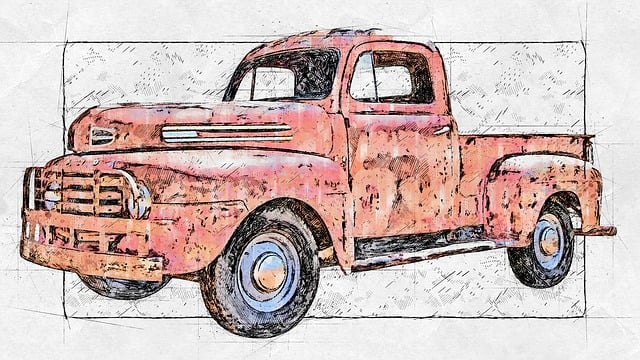Save Money with Top-Tier Aftermarket Collision Parts Installation
Aftermarket collision parts provide a cost-effective way to repair cars post-collision, maintaining…….
Welcome to an in-depth exploration of the world of aftermarket collision parts, a dynamic industry that plays a pivotal role in shaping the automotive landscape globally. This article aims to equip readers with a comprehensive understanding of this multifaceted sector, its impact on vehicle repairs, and its growing influence on sustainability, technology, and economic growth. By delving into various aspects, we will uncover how aftermarket collision parts are not just about fixing cars but also driving innovation, ensuring safety, and fostering environmental stewardship.
Definition: Aftermarket collision parts, a term that has gained prominence in recent years, refers to replacement components used in automotive repair and restoration processes following accidents or damage. These parts are distinct from original equipment manufacturer (OEM) parts, as they are produced by third-party manufacturers and designed to fit various makes and models of vehicles.
Core Components: The aftermarket collision parts ecosystem comprises several key elements:
Manufacturer/Distributor: These entities produce or source replacement parts, ensuring they meet specific industry standards for quality and performance. They play a vital role in distributing products to retailers, repair shops, and ultimately, consumers.
Retailers and Distributors: From local auto parts stores to online marketplaces, these intermediaries make aftermarket collision parts accessible to automotive professionals and DIY enthusiasts. They contribute to the efficient supply chain by stocking, organizing, and selling these components.
Repairs Shops/Mechanics: The end-users of aftermarket collision parts, repair shops rely on these products to restore vehicles to their pre-accident condition. Skilled mechanics install these parts, ensuring proper fitting and safety standards are met.
Historical Context: The concept of aftermarket collision parts has evolved over the past few decades, driven by increasing vehicle complexity, rising consumer expectations, and advancements in manufacturing technology. Historically, replacement parts were often costly and time-consuming to source, especially for specialized or vintage vehicles. However, with the rise of mass production techniques and global sourcing, aftermarket manufacturers emerged, offering more affordable and readily available alternatives.
International Influence: Aftermarket collision parts have become a global phenomenon, transcending geographical boundaries to cater to a diverse range of vehicle types and needs. The industry’s reach is evident in every region, from North America and Europe to Asia-Pacific and Latin America. This widespread adoption speaks to the universal need for efficient and cost-effective vehicle repairs.
Regional Trends: Each region brings its unique dynamics to the aftermarket collision parts landscape:
| Region | Trends |
|---|---|
| North America | Strong focus on advanced safety features, with parts designed to meet strict crash standards. High adoption of technology, including digital diagnostics tools for part compatibility. |
| Europe | Emphasis on environmental sustainability, with eco-friendly materials and recycling programs gaining traction. Strict regulations drive the development of high-quality, compatible parts. |
| Asia-Pacific | Rapidly growing market driven by increasing vehicle ownership and urbanization. Focus on cost-effectiveness and rapid delivery to meet the demands of a large and diverse automotive base. |
| Latin America | Emerging market with a growing demand for affordable parts, driven by economic factors. Local manufacturers are gaining ground, offering competitive pricing and tailored solutions. |
Market Size and Growth: The global aftermarket collision parts market has experienced significant growth over the past decade, projected to reach USD 207.3 billion by 2025, according to a recent study. This rapid expansion is attributed to various factors, including rising vehicle ownership, increasing road traffic, and growing awareness of cost-effective repair options.
Investment Patterns: The industry attracts substantial investment from both private equity firms and strategic investors. These investments are directed towards research and development, manufacturing infrastructure, and digital platforms to enhance the customer experience. Aftermarket collision part manufacturers are increasingly leveraging e-commerce, offering online ordering and delivery services to cater to modern consumers’ preferences.
Economic Impact: From a macroeconomic perspective, the industry contributes significantly to global GDP, creating numerous job opportunities in manufacturing, distribution, and retail. Moreover, it stimulates local economies, especially in regions with thriving aftermarket industries, fostering small business growth and employment.
Innovation Highlights: Aftermarket collision parts have been at the forefront of technological advancements, ensuring vehicles remain safe, efficient, and environmentally friendly. Some notable developments include:
Advanced Materials: The introduction of lightweight materials like aluminum and composite fibers has revolutionized crash-test performance and fuel efficiency. These materials offer superior strength while reducing vehicle weight, leading to improved overall safety and lower emissions.
Smart Sensors and Electronics: Integration of smart sensors and electronic control units (ECUs) in collision parts enhances vehicle safety and diagnostics. For example, advanced airbag systems now incorporate sensors that detect crash severity, deploying airbags more effectively and minimizing potential harm.
Digital Imaging and 3D Printing: Digital imaging techniques enable precise part measurements and design modifications. Additionally, 3D printing technology allows for on-demand manufacturing of custom collision parts, reducing lead times and costs.
Future Potential: The future holds immense potential for technological breakthroughs in aftermarket collision parts:
Artificial Intelligence (AI): AI can be leveraged to predict part failure, optimize supply chains, and enhance diagnostic capabilities, leading to more efficient repairs and reduced downtime.
Internet of Things (IoT): Connecting collision parts to IoT networks enables real-time data sharing, allowing manufacturers to gather insights for improved product design and performance.
Biomimicry: Drawing inspiration from nature, biomimetic materials can offer innovative solutions for crash energy absorption, inspired by the unique structures found in natural materials like bones and plant cells.
Regulatory Frameworks: The aftermarket collision parts industry operates within a complex web of regulations and standards, ensuring product safety and quality. Key players include:
National Highway Traffic Safety Administration (NHTSA): In the United States, NHTSA sets safety standards for vehicle components, including collision parts, to minimize risks and protect motorists.
European Union (EU) Regulations: The EU’s New Car Assessment Program (NCAP) and its strict crash testing requirements influence the design and performance of aftermarket collision parts across Europe.
International Organization for Standardization (ISO): ISO develops international standards for various industries, including automotive, ensuring compatibility and safety across borders.
Compliance Challenges: Compliance with these regulations can pose challenges for manufacturers, especially regarding product certification, testing, and documentation. Staying abreast of changing standards and maintaining a robust quality control system are essential for market success.
Main Concerns: While the aftermarket collision parts industry has witnessed remarkable growth and technological advancements, it faces several challenges and criticisms:
Product Quality and Safety: Ensuring consistent product quality and safety is a significant concern, particularly with the proliferation of counterfeit or substandard parts. Strict testing and certification processes are necessary to protect consumers.
Environmental Impact: The industry’s environmental footprint, especially in terms of raw material sourcing and disposal, has come under scrutiny. Adopting sustainable practices, such as recycling and using eco-friendly materials, is essential for long-term viability.
Intellectual Property (IP) Issues: Patent protections and IP rights are critical for manufacturers to safeguard their innovations. However, managing IP in a global market presents challenges, requiring robust legal frameworks and proactive enforcement.
Proposed Solutions: To address these issues, a multi-faceted approach is recommended:
Industry Collaboration: Manufacturers, regulators, and repair shops can collaborate to establish clear standards and guidelines for product quality and safety.
Digital Transparency: Implementing digital tracking systems and blockchain technology can ensure the authenticity of parts, reduce counterfeiting, and provide consumers with transparent supply chain information.
Sustainability Initiatives: Industry leaders should embrace sustainable practices, including eco-friendly material sourcing, recycling programs, and energy-efficient manufacturing processes.
Case Study 1: Japan’s Aftermarket Revolution
Japan’s aftermarket collision parts industry is a testament to innovation and efficiency. The country’s focus on advanced technology has resulted in the development of high-precision parts, ensuring vehicles maintain their safety and performance standards even after accidents. Japanese manufacturers’ adherence to strict quality control measures has made their products renowned globally for reliability and compatibility. This success story highlights the importance of technological prowess and rigorous standards in gaining market trust.
Case Study 2: Eco-Friendly Parts in Europe
In response to European Union regulations, several aftermarket collision part manufacturers have embraced sustainability as a core strategy. For example, a German company has developed a range of plastic parts made from recycled materials, significantly reducing the environmental impact of vehicle repairs. This initiative not only aligns with EU guidelines but also demonstrates that eco-friendly products can be competitive in terms of quality and price.
Growth Areas: The future holds immense potential for growth and innovation in the aftermarket collision parts sector:
Electric Vehicles (EVs): With the rise of electric vehicles, there will be a growing demand for specialized collision parts designed for these new energy systems. Manufacturers must adapt to the unique challenges posed by EV repairs and safety considerations.
Autonomous Vehicles: As autonomous driving technology advances, so too will the need for specialized collision parts capable of withstanding sensor and electronic system failures.
Global Expansion: Emerging markets in Asia and Latin America present significant opportunities for expansion, driven by increasing vehicle ownership and a growing middle class.
Emerging Trends: Keep an eye on these emerging trends:
Digital Transformation: The industry is poised for further digital integration, with advanced online platforms offering personalized part recommendations, virtual fitting, and seamless ordering experiences.
Data Analytics: Utilizing big data analytics can optimize inventory management, predict part failures, and enhance overall operational efficiency.
Collaborative Economy: Sharing economy principles may influence the aftermarket collision parts landscape, fostering peer-to-peer part sharing and repair services.
Aftermarket collision parts have emerged as a dynamic and influential sector within the automotive industry, playing a pivotal role in shaping vehicle repairs and maintenance. From its humble beginnings to its current global footprint, this industry has embraced technological advancements, regulatory challenges, and sustainability goals, positioning itself as a key driver of innovation and progress.
As we look ahead, the aftermarket collision parts landscape is set to evolve further, influenced by emerging technologies, shifting consumer preferences, and stricter environmental regulations. By addressing challenges and embracing opportunities, manufacturers, regulators, and repair shops can ensure that this industry continues to deliver high-quality, safe, and sustainable solutions for vehicle repairs worldwide.
Q: How can I ensure the quality of aftermarket collision parts?
A: Look for reputable brands with a proven track record of quality. Check for certifications and warranties, and always purchase from trusted retailers or manufacturers.
Q: Are aftermarket collision parts more expensive than OEM parts?
A: Not necessarily. While some high-end parts may be pricier, many aftermarket options offer excellent value for money, especially when considering their performance, compatibility, and availability.
Q: Can I install aftermarket collision parts myself, or do I need a professional?
A: Many aftermarket parts are designed for DIY installation, providing step-by-step guides and videos. However, complex repairs or those involving safety-critical components may require professional mechanics for optimal results and safety standards.
Q: How does the environment benefit from using aftermarket collision parts?
A: Aftermarket manufacturers are increasingly adopting sustainable practices, including eco-friendly materials, recycling programs, and energy-efficient manufacturing. These initiatives help reduce the industry’s environmental footprint and promote a greener approach to vehicle repairs.
Q: Are there any legal considerations when buying aftermarket collision parts?
A: Yes, it’s essential to purchase parts from legitimate sources to avoid counterfeit or substandard products. Always check for warranties, return policies, and consumer protection laws to ensure a safe and legally sound transaction.

Aftermarket collision parts provide a cost-effective way to repair cars post-collision, maintaining…….

Aftermarket collision parts are cost-effective alternatives to OEM components for vehicle repairs af…….

Aftermarket collision parts coverage under auto insurance can be complex, with policies often exclud…….

Aftermarket collision parts play a crucial role in vehicle resale value, offering cost-effective alt…….

Aftermarket collision parts are cost-effective alternatives to OEM components for auto repair, but q…….

Aftermarket collision parts are a cost-effective and convenient solution for car owners needing auto…….